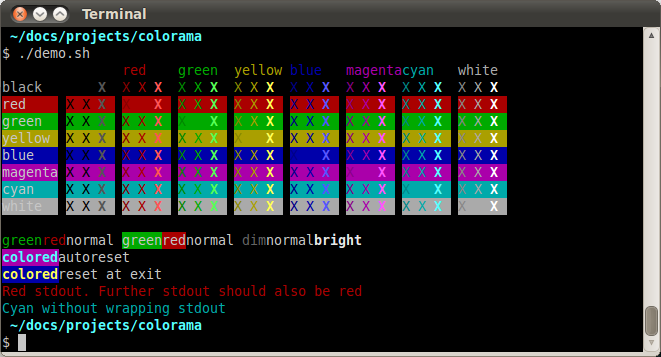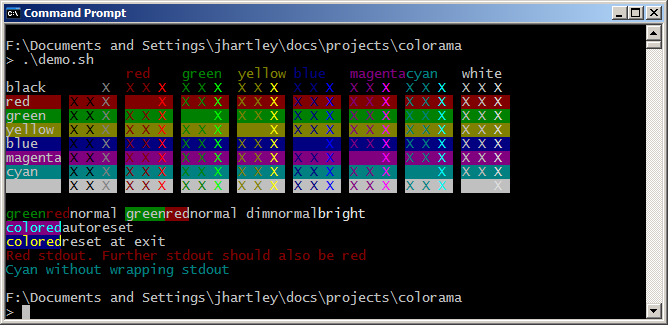Cross-platform colored terminal text.
Project description

- Download and docs:
- Development:
- Discussion group:
Description
Makes ANSI escape character sequences for producing colored terminal text and cursor positioning work under MS Windows.
ANSI escape character sequences have long been used to produce colored terminal text and cursor positioning on Unix and Macs. Colorama makes this work on Windows, too, by wrapping stdout, stripping ANSI sequences it finds (which otherwise show up as gobbledygook in your output), and converting them into the appropriate win32 calls to modify the state of the terminal. On other platforms, Colorama does nothing.
Colorama also provides some shortcuts to help generate ANSI sequences but works fine in conjunction with any other ANSI sequence generation library, such as Termcolor (http://pypi.python.org/pypi/termcolor.)
This has the upshot of providing a simple cross-platform API for printing colored terminal text from Python, and has the happy side-effect that existing applications or libraries which use ANSI sequences to produce colored output on Linux or Macs can now also work on Windows, simply by calling colorama.init().
An alternative approach is to install ‘ansi.sys’ on Windows machines, which provides the same behaviour for all applications running in terminals. Colorama is intended for situations where that isn’t easy (e.g. maybe your app doesn’t have an installer.)
Demo scripts in the source code repository prints some colored text using ANSI sequences. Compare their output under Gnome-terminal’s built in ANSI handling, versus on Windows Command-Prompt using Colorama:


These screengrabs show that Colorama on Windows does not support ANSI ‘dim text’: it looks the same as ‘normal text’.
License
Copyright Jonathan Hartley 2013. BSD 3-Clause license, see LICENSE file.
Dependencies
None, other than Python. Tested on Python 2.5.5, 2.6.5, 2.7, 3.1.2, and 3.2
Usage
Initialisation
Applications should initialise Colorama using:
from colorama import init init()
If you are on Windows, the call to init() will start filtering ANSI escape sequences out of any text sent to stdout or stderr, and will replace them with equivalent Win32 calls.
Calling init() has no effect on other platforms (unless you request other optional functionality, see keyword args below.) The intention is that applications can call init() unconditionally on all platforms, after which ANSI output should just work.
To stop using colorama before your program exits, simply call deinit(). This will restore stdout and stderr to their original values, so that Colorama is disabled. To start using Colorama again, call reinit(), which wraps stdout and stderr again, but is cheaper to call than doing init() all over again.
Colored Output
Cross-platform printing of colored text can then be done using Colorama’s constant shorthand for ANSI escape sequences:
from colorama import Fore, Back, Style
print(Fore.RED + 'some red text')
print(Back.GREEN + 'and with a green background')
print(Style.DIM + 'and in dim text')
print(Fore.RESET + Back.RESET + Style.RESET_ALL)
print('back to normal now')
or simply by manually printing ANSI sequences from your own code:
print('\033[31m' + 'some red text')
print('\033[30m' # and reset to default color)
or Colorama can be used happily in conjunction with existing ANSI libraries such as Termcolor:
from colorama import init
from termcolor import colored
# use Colorama to make Termcolor work on Windows too
init()
# then use Termcolor for all colored text output
print(colored('Hello, World!', 'green', 'on_red'))
Available formatting constants are:
Fore: BLACK, RED, GREEN, YELLOW, BLUE, MAGENTA, CYAN, WHITE, RESET. Back: BLACK, RED, GREEN, YELLOW, BLUE, MAGENTA, CYAN, WHITE, RESET. Style: DIM, NORMAL, BRIGHT, RESET_ALL
Style.RESET_ALL resets foreground, background and brightness. Colorama will perform this reset automatically on program exit.
Cursor Positioning
ANSI codes to reposition the cursor are supported. See demos/demo06.py for an example of how to generate them.
Init Keyword Args
init() accepts some kwargs to override default behaviour.
- init(autoreset=False):
If you find yourself repeatedly sending reset sequences to turn off color changes at the end of every print, then init(autoreset=True) will automate that:
from colorama import init init(autoreset=True) print(Fore.RED + 'some red text') print('automatically back to default color again')- init(strip=None):
Pass True or False to override whether ansi codes should be stripped from the output. The default behaviour is to strip if on Windows.
- init(convert=None):
Pass True or False to override whether to convert ansi codes in the output into win32 calls. The default behaviour is to convert if on Windows and output is to a tty (terminal).
- init(wrap=True):
On Windows, colorama works by replacing sys.stdout and sys.stderr with proxy objects, which override the .write() method to do their work. If this wrapping causes you problems, then this can be disabled by passing init(wrap=False). The default behaviour is to wrap if autoreset or strip or convert are True.
When wrapping is disabled, colored printing on non-Windows platforms will continue to work as normal. To do cross-platform colored output, you can use Colorama’s AnsiToWin32 proxy directly:
import sys from colorama import init, AnsiToWin32 init(wrap=False) stream = AnsiToWin32(sys.stderr).stream # Python 2 print >>stream, Fore.BLUE + 'blue text on stderr' # Python 3 print(Fore.BLUE + 'blue text on stderr', file=stream)
Status & Known Problems
I’ve personally only tested it on WinXP (CMD, Console2), Ubuntu (gnome-terminal, xterm), and OSX.
Some presumably valid ANSI sequences aren’t recognised (see details below) but to my knowledge nobody has yet complained about this. Puzzling.
See outstanding issues and wishlist, still on Google code for the time being: http://code.google.com/p/colorama/issues/list
If anything doesn’t work for you, or doesn’t do what you expected or hoped for, I’d love to hear about it on that issues list, would be delighted by patches, and would be happy to grant commit access to anyone who submits a working patch or two.
Recognised ANSI Sequences
ANSI sequences generally take the form:
ESC [ <param> ; <param> … <command>
Where <param> is an integer, and <command> is a single letter. Zero or more params are passed to a <command>. If no params are passed, it is generally synonymous with passing a single zero. No spaces exist in the sequence, they have just been inserted here to make it easy to read.
The only ANSI sequences that colorama converts into win32 calls are:
ESC [ 0 m # reset all (colors and brightness)
ESC [ 1 m # bright
ESC [ 2 m # dim (looks same as normal brightness)
ESC [ 22 m # normal brightness
# FOREGROUND:
ESC [ 30 m # black
ESC [ 31 m # red
ESC [ 32 m # green
ESC [ 33 m # yellow
ESC [ 34 m # blue
ESC [ 35 m # magenta
ESC [ 36 m # cyan
ESC [ 37 m # white
ESC [ 39 m # reset
# BACKGROUND
ESC [ 40 m # black
ESC [ 41 m # red
ESC [ 42 m # green
ESC [ 43 m # yellow
ESC [ 44 m # blue
ESC [ 45 m # magenta
ESC [ 46 m # cyan
ESC [ 47 m # white
ESC [ 49 m # reset
# cursor positioning
ESC [ y;x H # position cursor at x across, y down
# clear the screen
ESC [ mode J # clear the screen. Only mode 2 (clear entire screen)
# is supported. It should be easy to add other modes,
# let me know if that would be useful.
Multiple numeric params to the ‘m’ command can be combined into a single sequence, eg:
ESC [ 36 ; 45 ; 1 m # bright cyan text on magenta background
All other ANSI sequences of the form ESC [ <param> ; <param> ... <command> are silently stripped from the output on Windows.
Any other form of ANSI sequence, such as single-character codes or alternative initial characters, are not recognised nor stripped. It would be cool to add them though. Let me know if it would be useful for you, via the issues on google code.
Development
Help and fixes welcome! Ask Jonathan for commit rights, you’ll get them.
Running tests requires:
Michael Foord’s ‘mock’ module to be installed.
Tests are written using the 2010 era updates to ‘unittest’, and require to be run either using Python2.7 or greater, or else to have Michael Foord’s ‘unittest2’ module installed.
To run tests:
python -m unittest discover -p *_test.py
This, like a few other handy commands, is captured in a Makefile.
If using nose to run the tests, pass the -s flag required because ‘nosetests’ otherwise applies a proxy of its own to stdout, which confuses the unit tests.
Contact
Created by Jonathan Hartley, tartley@tartley.com
Thanks
Project details
Release history Release notifications | RSS feed
Download files
Download the file for your platform. If you're not sure which to choose, learn more about installing packages.
Source Distributions
File details
Details for the file colorama-0.3.2.zip.
File metadata
- Download URL: colorama-0.3.2.zip
- Upload date:
- Size: 32.2 kB
- Tags: Source
- Uploaded using Trusted Publishing? No
File hashes
| Algorithm | Hash digest | |
|---|---|---|
| SHA256 | f1ae1669bb4009aeed392a8df008d6926b434ee811b663a30ae673c09263c25b |
|
| MD5 | 179cc70c4a61901ffd052576b598f11e |
|
| BLAKE2b-256 | 13b4ccc34a878c59993a36b3f6d967d34eafbcdf07657e54ef1d051570e0c0e9 |
File details
Details for the file colorama-0.3.2.tar.gz.
File metadata
- Download URL: colorama-0.3.2.tar.gz
- Upload date:
- Size: 18.3 kB
- Tags: Source
- Uploaded using Trusted Publishing? No
File hashes
| Algorithm | Hash digest | |
|---|---|---|
| SHA256 | 218862857d74ff781c2caf44629a7d72b88bbb8a2b0aa0f4f1eb8666f8305c11 |
|
| MD5 | 2949d760dfe510a74f5bf4287d474f33 |
|
| BLAKE2b-256 | 29dc191dae95b02cb82088b29027ac88d48a3e43f7f12c0543d00c565b3d2f40 |












